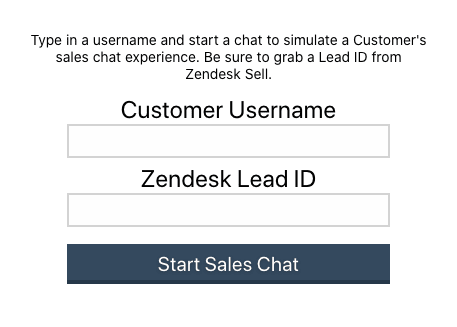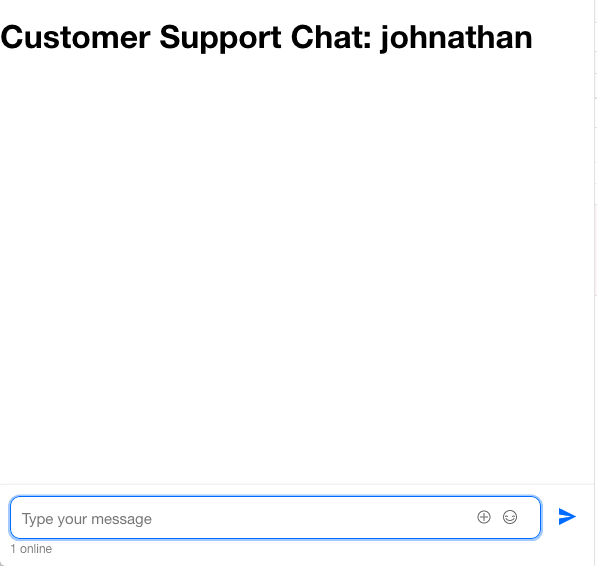Can you imagine viewing your sales chat transcripts in real time from your sales CRM? Would your chat applications improve with more timely handling of customer chat inquiries? This post demonstrates how to leverage the powerful Stream Chat API to take action with a chat transcript as the chat takes place, response by response. The techniques provided here will help you better understand key components of the Stream Chat API, so that you can leverage them for similar applications, either with Zendesk Sell or other CRMs.
We show this through the use case of updating a Zendesk Sell Lead in real-time with the transcript messages of a Customer.
The simplified process of this post simulates a customer starting a sales chat. The customer chat components pass the chat message to a backend API, which is the focus of this post. The backend calls the Zendesk Sell API to update the desired Lead Description. You will see that the Zendesk lead description is updated after the customer sends a message. The flow is illustrated below.
Note: we only focus on the Customer experience in this post. Similar steps can be taken to sync the admin messages.
Technical Overview
The applications described in this post are composed of:
-
frontendwhich runs on http://localhost:3000/. This application supports the customer experience. -
backendwhich runs on http://localhost:8080/. This application will facilitate communication with Stream and Zendesk.
The frontend is bootstrapped using create-react-app, and the backend server is an Express app running on nodejs. Both the frontend and backend leverage Stream's JavaScript library. The backend employs axios to interact with the Zendesk Sell API. All the code required for this tutorial is available in the GitHub repository.
Prerequisites
To follow along with the post, you will need a free Stream account, and a Zendesk Sell account (a Zendesk Trial can be obtained here).
The code in this post is intended to run locally and assumes a basic knowledge of React and React Hooks, Express, Node.js, and axios. The basic steps to configure Zendesk and use the API are explained in the post (see the Zendesk Sell API documentation to learn more). Please note, however, that you will need to create at least one Lead manually in Zendesk and use the Lead ID when logging in, as described below. Automatic Lead creation is possible, but is extracurricular to this post. If you want to see how to generate these leads programmatically when entering starting a Stream chat, see this post.
Configuration
This application requires three environment variables to be configured:
- STREAM_API_KEY
- STREAM_API_SECRET
- ZENDESK_CRM_TOKEN
You will find a file in the backend folder, .env.example, that you can rename to create a .env file.
When the .env file has been created and configured, you can start the backend by npm start command from the backend folder.
Before we do anything we start anything we need to create and configure our accounts.
Let's get started!
Registering and Configuring Zendesk
To integrate Stream with the Zendesk Sell API, you must configure the OAuth security settings in Zendesk Sell with the following steps:
- Click on the
Settingsgear to the right of the top menu
- Click on
OAuthunder theIntegrationsmenu
- Click on
+ Add Access Token
- Complete description and leave settings unchanged (more restrictive settings may be required for your application) and click
Save
- Copy the access token, which you will need to configure your backend communication with Zendesk.
Update you're .env file with the token you just generated.
Registering and Configuring Stream
Now we can configure Stream. To get the Stream credentials, navigate to your Stream.io Dashboard
Then click on "Create App"
Give your app a name and select "Development" and click "Submit"
Stream will generate a key and secret for your app. Copy these and update the corresponding environment variables in the .env file.
Step 1 - Starting a Chat
First, let's build a React frontend that allows you to start a chat as a Customer. Here's what our simplified logins screen looks like.
Let's start by modifying the App.js file that was generated by create-react-app:
// frontend/src/App.js:5
function App() {
const [username, setUsername] = useState('');
const [leadId, setLeadId] = useState('');
const [channel, setChannel] = useState(null);
const [chatClient, setChatClient] = useState(null);
const startChat = async () => {
// ...
}
if (channel && chatClient) {
return <SalesChat username={username} leadId={leadId} channel={channel} chatClient={chatClient}/>;
} else {
return <div className="login">
<div className="login-description">
Type in a username and start a chat to simulate a Customer's sales chat experience. Be sure to grab a Lead ID from Zendesk Sell.
</div>
<label>Customer Username</label>
<input
type="text"
value={username}
onChange={(e) => setUsername(e.target.value)}
required
/>
<label>Zendesk Lead ID</label>
<input
type="text"
value={leadId}
onChange={(e) => setLeadId(e.target.value)}
required
/>
<button onClick={startChat}>Start Sales Chat</button>
</div>
}
}
We first present the user with the form (displayed above). This form contains a username, a leadId (to identify the Zendesk Sell lead record), and a button to start the chat. We use useState to keep track of the values of each of these fields.
To keep this post focused, we won't generate leads dynamically. This means we'll need to input the lead id from Zendesk manually. To grab our lead id, go to your Zendesk dashboard and navigate to the "Leads" section. If you don't have a lead, click on "Add" and then "Add Lead". Fill in the necessary information then click "Save". Once you've done that you should see a lead id in the URL. It will be a 6-8 digit number such as 3180101.
Once you've filled out your username and leadId, after you can click "Start Sales Chat". Upon clicking this, we fire our startChat function:
const startChat = async () => {
const response = await axios.post("http://localhost:8080/stream-chat-credentials", {
username, leadId
});
const token = response.data.token;
const channelId = response.data.channelId;
const chatClient = new StreamChat(response.data.apiKey);
await chatClient.setUser({ id: response.data.userId, name: response.data.userName }, token);
const channel = chatClient.channel("messaging", channelId);
setChatClient(chatClient);
setChannel(channel);
}
Here we post our username and leadId to our backend. We'll look at what our backend does in a second, but first, let's see how our frontend handles the response. Our backend will return a few pieces of data required to configure our frontend client. Using the apiKey we set up our frontend StreamChat instance. We then configure the chat instance with the userId, userName, and the Stream frontend token. Once our client is configured, we can create a reference to our channel via the channelId. We then set the React component's chatClient and channel state.
Before we move on to rendering the chat channel, let's look at the backend /stream-chat-credentials handler:
// backend/server.js:15
const streamClient = new StreamChat(
process.env.STREAM_API_KEY,
process.env.STREAM_API_SECRET
);
// ...
// backend/server.js:57
app.post("/stream-chat-credentials", async (req, res) => {
const { username } = req.body;
try {
let user = { id: username, name: username, role: 'user' };
await streamClient.upsertUsers([user]);
const channel = streamClient.channel('messaging', username, {
name: 'Sales Chat',
created_by_id: 'sales-admin'
});
await channel.create();
await channel.addMembers([username]);
const token = streamClient.createToken(user.id);
res.send({
userId: user.id,
userName: user.name,
channelId: channel.id,
token,
apiKey: process.env.STREAM_API_KEY
});
} catch (err) {
console.log(err);
}
});
Here we take the username from the request. We use our streamClient to create or update the user. Then we create a chat channel that is private to that user (and any admin user). Once the chat channel is set up, we generate the user's frontend token and respond to the user with the necessary data.
Step 2: Displaying a Stream Chat Channel
Once you've started a chat you will see a screen that looks like this:
As you can see in Step 1, we have the data we need to mount the SalesChat component. This component takes the user information (username and leadId) and our Stream data (chatClient and channel). The process flow of this component is to render the chat experience, hook into the message lifecycle, send each message to our backend, then update the Lead in Zendesk Sell. Here's the entire component:
// frontend/src/SalesChat.js:7
function SalesChat({ username, leadId, chatClient, channel }) {
async function handleMessage(_channelId, message) {
await axios.post("http://localhost:8080/messages", { message, author: username, leadId: leadId });
return channel.sendMessage(message);
}
return (
<Chat client={chatClient} theme="commerce light">
<Channel channel={channel} doSendMessageRequest={handleMessage}>
<Window>
<h1>
Customer Support Chat: {channel.id}
</h1>
<MessageList/>
<MessageInput focus/>
</Window>
</Channel>
</Chat>
);
}
Using the chatClient and channel we render the chat experience with Stream's Chat Messaging UI Kit. The component hooks into the message lifecycle by configuring the Channel component's doSendMessageRequest prop. This prop allows us to intercept the message before it goes to Stream's API. Inside of handleMessage we send the message, along with the author and leadId to our backend's /messages endpoint. Once the message has been handled by our backend, we send the message to the channel by calling sendMessage.
Step 3: Syncing the Chat Transcript on Every Message
Now that we have our chat experience mounted and are sending every message to our backend, we can sync these messages to our Zendesk Lead. Here's our /messages endpoint:
// backend/server.js:33
app.post('/messages', async (req, res) => {
try {
const leadId = req.body.leadId;
let previousTranscript = await getPreviousTranscript(leadId);
const payload = {
'description': `${previousTranscript}\n${req.body.author}: ${req.body.message.text}`
}
const headers = {
'Accept': 'application/json',
'Content-Type': 'application/json',
'Authorization': `Bearer ${process.env.ZENDESK_CRM_TOKEN}`
}
await axios.put(
'https://api.getbase.com/v2/leads/' + leadId,
{ data: payload },
{ headers: headers }
);
res.send({});
} catch (err) {
console.log(err);
res.status(500);
}
});
This endpoint appends the new message and author to the description field. Every time we update the description field, it will overwrite the previous data. Therefore, we need to look up the previous transcript via getPreviousTranscript, and append the new message to it:
// backend/server.js:20
async function getPreviousTranscript(leadId) {
const headers = {
'Accept': 'application/json',
'Content-Type': 'application/json',
'Authorization': `Bearer ${process.env.ZENDESK_CRM_TOKEN}`
}
const response = await axios.get(
`https://api.getbase.com/v2/leads/${leadId}`,
{ headers: headers }
);
return response.data.data.description || '';
}
This is simply a GET against the lead to get the previous description field out. Once we have the previous description we issue a PUT to update the lead with the new description field containing our appended message.
That does it! You now understand how to integrate Stream Chat with Zendesk Sell to update Lead Descriptions (or any other Zendesk field as needed) during your sales chat experience.
Originally published at https://getstream.io














Top comments (0)